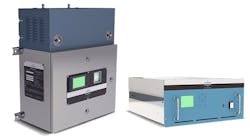Advances in laser-based gas analyzers improve process monitoring and control
The value of accurate gas analysis to a facility with complex industrial processes is considerable; however, obtaining the data for accurate analysis of gas components and their concentration is not always as easy as we would like. Depending on the tools used to collect data, the level of detail can vary. A closer look at the advances in laser-based gas analyzers shows what is possible.
The need to accurately monitor emissions, ensure product quality and enhance process control in complex industrial processes requires a continuous and highly precise analysis of a wide range of gases. These measurements are equally necessary to meet environmental regulations, optimize production and ensure safety. However, conventional single laser absorption spectrometry analyzers have a limited detection coverage of one or two gas components because they operate in the near-infrared using tunable diode lasers (TDL), limiting their sensitivity, accuracy and access to a wider spectrum of gas molecules. These limitations affect their ability to provide high-resolution analysis of multiple gas components without the deployment of multiple analyzers, increasing the cost of ownership, the footprint of required equipment and the operational complexity.
Recent advances in laser-based absorption techniques include instruments that employ mid-infrared quantum cascade lasers (QCL) in conjunction with near-infrared detection to provide sub-parts per billion gas analysis in environmental applications and industrial process and product quality control monitoring.
This new league of instruments includes the Emerson Rosemount Quantum Cascade Laser Gas Analyzers — the world’s first hybrid laser analyzers that combine TDL and QCL measurement technologies to expand the gas analysis to both the near and mid-infrared range using a patented laser chirp technique.
This intra-pulse spectroscopic technique pulses the laser every microsecond, providing an instantaneous high-resolution frequency sweep through a broad wavelength covering many gas species and allowing the analyzer to accurately quantify the concentration of trace gases in complex gaseous mixtures. The result is real-time detection of up to 8 different gases simultaneously in a single instrument.
Other key advantages of this hybrid laser gas analysis technology include:
- Up to a million measurements a second, providing fast response times and insight into the process.
- Enhanced gas analysis selectivity, delivering reliable measurement and specificity of components in complex gaseous mixtures.
- Tremendous sensitivity, expanding detection range down to ultra-trace levels to monitor contaminants in the production of ultra-high purity gases.
- Simultaneous multiple gas measurement enabling broad application flexibility.
Highly precise detection is ensured by an advanced signal processing procedure that enables real-time validation of measurements, greatly reducing the need for calibrations and eliminating consumables and sample pre-treatments.
Rosemount Quantum Cascade Laser Gas Analyzers can be used in safe and hazardous areas and are available in purged and pressurized enclosures, half-rack and 19-inch rack enclosures. Servicing Rosemount Quantum Cascade Laser Gas Analyzers is easy. The modular design of the lasers means they are field replaceable to accommodate future upgrades without requiring an experienced operator to replace the modules. With extremely rugged laser modules, alignment of the mirrors and lasers is not necessary during the mounting or unmounting of the modules.
Advances in both QCL technology and spectrometer hardware, when combined with spectroscopic techniques such as intra-pulse spectroscopy, offer a major step-change in sensitivity, speed of operation, selectivity, size and cost over other methods of gas detection. The technology allows users to meet the requirements of modern process analytics without losing out on powerful performance, low cost of ownership and operational simplicity.

